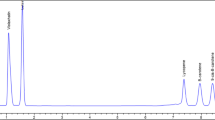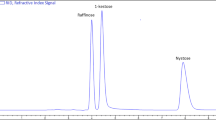Abstract
The present work reports the compositional analysis of thirteen different packed fruit juices using high performance liquid chromatography (HPLC). Vitamin C, organic acids (citric and malic) and sugars (fructose, glucose and sucrose) were separated, analyzed and quantified using different reverse phase methods. A new rapid reverse phase HPLC method was developed for routine analysis of vitamin C in fruit juices. The precision results of the methods showed that the relative standard deviations of the repeatability and reproducibility were <0.05 and <0.1 respectively. Correlation coefficient of the calibration models developed was found to be higher than 0.99 in each case. It has been found that the content of Vitamin C was less variable amongst different varieties involved in the study. It is also observed that in comparison to fresh juices, the packed juices contain lesser amounts of vitamin C. Citric acid was found as the major organic acids present in packed juices while maximum portion of sugars was of sucrose. Comparison of the amount of vitamin C, organic acids and sugars in same fruit juice of different commercial brands is also reported.



Similar content being viewed by others
References
Almagro I, San Andres MP, Vera S (2002) Determination of water soluble vitamins in pharmaceutical preparations by reversed-phase high performance liquid chromatography with a mobile phase containing sodium dodecyl sulphate and n-propanol. Chromatographia 55:185–188
Anyakora C, Afolami I, Ehianeta T, Onwumere F (2008) HPLC analysis of nicotinamide, pyridoxine, riboflavin and thiamin in some selected food products in Nigeria. Afr J Pharm Pharmaco 2(2):29–36
Arora S, Shendurse AM, Sharma V, Wadhwa BK, Singh AK (2011) Assessment of stability of binary sweetener blend (aspartame x acesulfame-K) during storage in whey lemon beverage. J Food Sci Technol. doi:10.1007/s13197-011-0386-0
Belajova E, Suhaj M (2004) Determination of phenolic constituents in citrus juices: Method of high performance liquid chromatography. Food Chem 86:339–343
Bhattacherjee AK, Tandon DK, Dikshit A, Kumar S (2010) Effect of pasteurization temperature on quality of aonla juice during storage. J Food Sci Technol 48(3):269–273
Blatny P, Kvasnicka F, Kenndler E (1995) Determination of phytic acid in cereal grains, legumes, and feeds by capillary isotachophoresis. J Agric Food Chem 43:129–133
Castellari M, Versari A, Spinabelli U, Galassi S, Amati A (2000) An improved HPLC method for the analysis of organic acids, carbohydrates, and alcohols in grape musts and wines. J Liq Chromatogr Relat Technol 23:2047–2056
Chen H, Zhang Y, Lu X, Qu Z (2011) Comparative studies on the physicochemical and antioxidant properties of different tea extracts. J Food Sci Technol. doi:10.1007/s13197-011-0291-6
Chen Y, Chen J, Luo Z, Ma K, Chen X (2008) Synchronous fluorescence analysis of phytate in food. Michrochim Acta 164:35–40
Chinnici F, Spinabelli U, Riponi C, Amati A (2005) Optimization of the determination of organic acids and sugars in fruit juices by ion-exclusion liquid chromatography. J Food Compos Anal 18:121–130
Cunha SC, Fernandes JO, Ferriera IM (2002) HPLC/UV determination of organic acids in fruit juices and nectars. Eur Food Res Technol 214:67–71
Eisele TA, Drake SR (2004) The partial compositional characteristics of apple juice from 175 apple varieties. J Food Comp Anal 18:213–221
Fang F, Li JM, Pan QH, Huang WD (2007) Determination of red wine flavonoids by HPLC and effect of aging. Food Chem 101(1):428–433
Fish WW, Perkins-Veazie P, Collins JK (2002) A quantitative assay for lycopene that utilizes reduced volumes of organic solvents. J Food Compos Anal 15(3):309–317
Gattuso G, Barreca D, Caristi C, Gargiulli C, Leuzzi U (2007) Distribution of flavonoids and furocoumarins in juices from cultivars of citrus bergamia risso. J Agric Food Chem 55(4):9921–9927
George V, Arora S, Wadhwa BK, Singh AK (2010) Analysis of multiple sweeteners and their degradation products in lassi by HPLC and HPTLC plates. J Food Sci Technol 47(4):408–413
Han YS, Cui YL (1996) Determination of d-isocitrate in orange and its juice by enzymatic method. Acta Nutrimenta Sinica 18(1):120–125
Ikeda G, Tomizawa A, Imayoshi Y, Iwabuchi H, Hinata T, Sagara Y (2006) Flavor design of sesame-flavored dressing using gas chromatography/olfactometry and food kansei model. Food Sci Technol Res 12:261–269
Jahren AH, Saudek C, Yeung EH, Linda Kao WH, Kraft RA, Caballero B (2006) An isotopic method for quantifying sweeteners derived from corn and sugar cane. Am J Clin Nutr 84:1380–1384
Kabasakalis V, Moshatou E, Siopidou D (2000) Ascorbic acid content of commercial fruit juices and its rate of loss upon storage. Food Chem 70:325–328
Kafkas E, Kosar M, Turemis N, Baser KHC (2006) Analysis of sugars, organic acids and vitamin C contents of blackberry genotypes from Turkey. Food Chem 97(4):732–736
Kapor MA, Yamanaka H, Carneiro PA, Zanoni MVB (2001) Electroanalysis of food dyes: determination of indigo-carmine and tartrazine. Eclet Quím 26:53–68
Karadeniz F (2003) Main organic acid distribution of authentic citrus juices in Turkey. Turk J Agric For 28:267–271
Lehotay SJ, Hajslova J (2002) Application of gas chromatography in food analysis. Trends Anal Chem 21(9):686–697
Maia AM, Baby AR, Yasaka WJ, Suenaga E, Kaneko TM, Velasco VMR (2006) Validation of HPLC stability-indicating method for vitamin C in semisolid pharmaceutical/cosmetic preparations with glutathione and sodium metabisulfite, as antioxidants. Talanta 71:639–643
Marconi O, Floridi S, Montanari L (2007) Organic acids profile in tomato juice by HPLC with UV detection. J Food Qual 30:253–266
Muntean E, Bele C, Socaciu C (2003) HPLC analysis of carotenoids from fruits of Cucurbita pepo L. var. melopepo Alef. Acta Agro Hung 51:455–459
Nour V, Trandafir I, Ionica ME (2010) HPLC organic acid analysis in different citrus juices under reversed phase conditions. Not Bot Hort Agrobot Cluj 38(1):44–48
Sanchez-mata Maria DE, Camara-hurtado M, Diez-marques C (2002) Identification and quantification of soluble sugars in green beans by HPLC. Eur Food Res Technol 214:254–258
Sergio GA, Esteban GR, Isidro HG (2007) HPLC analysis of diverse grape and wine phenolics using direct injection and multidetection by DAD and fluorescence. J Food Compos Anal 20:618–629
Shui G, Leong LA (2002) Separation and determination of organic acids and phenolic compounds in fruit juices and drinks by high-performance liquid chromatography. J Chromatogr A 977:89–96
Silva FO, Ferraz V (2004) Microwave-assisted preparation of sugars and organic acids for simultaneous determination in citrus fruits by gas chromatography. Food Chem 88(4):609–612
Soyer Y, Koca N, Karadeniz F (2003) Organic acid profile of Turkish white grapes and grape juices. J Food Compos Anal 16:629–636
Timpa JD, Burke JJ (1986) Monitoring organic acids and carbohydrates in cotton leaves by high performance liquid chromatography. J Agric Food Chem 34(5):910–913
Venkateswaran V, Vijayalakshmi G (2010) Finger millet (Eleusine coracana)—an economically viable source for antihypercholesterolemic metabolites production by Monascus purpureus. J Food Sci Technol 47(4):426–431
Vera E, Sandeaux J, Persin F, Pourcelly G, Dornier M, Rouales J (2006) Deacidification of clarified tropical fruit juices by electrodialysis. Part I. Influence of operating conditions on the process performances. J Food Eng 78(4):1427–1438
Versari A, Parpinello GP, Mattioli AU, Galassi S (2008) Characterization of Italian commercial apricot juices by high-performance liquid chromatography analysis and multivariate analysis. Food Chem 108(1):334–340
Zeppa G, Conterno L, Gerbi V (2001) Determination of organic acids, sugars, diacetyl, and acetoin in cheese by high-performance liquid chromatography. J Agric Food Chem 49:2722–2726
Acknowledgement
Authors are thankful to Department of Biotechnology, India for providing the financial support (Grant No. BT/PR7221/MED/14/970/2006).
Author information
Authors and Affiliations
Corresponding author
Rights and permissions
About this article
Cite this article
Tyagi, G., Jangir, D.K., Singh, P. et al. Rapid determination of main constituents of packed juices by reverse phase-high performance liquid chromatography: an insight in to commercial fruit drinks. J Food Sci Technol 51, 476–484 (2014). https://doi.org/10.1007/s13197-011-0502-1
Revised:
Accepted:
Published:
Issue Date:
DOI: https://doi.org/10.1007/s13197-011-0502-1




